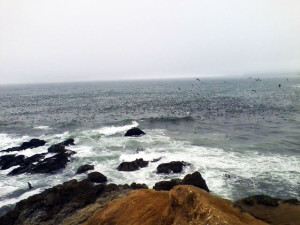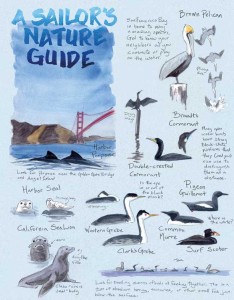Q: Do you remember this old limerick?
A wonderful bird is the pelican,
His bill can hold more than his belly can,
He can take in his beak,
Food enough for a week!
But I’m damned if I know how the hell he can!
–Dixon Lanier Merritt
So is it really true? [Sue, Oakland]
A: The pelican’s pouch, more properly referred to as the gular sac, has several different functions. The first and most obvious is to procure food. The brown pelican we see along our coast hunts by plunging into a school of fish from a few dozen feet in the air; the greatly distensible sac opens upon impact and two and a half gallons of water (and any fish nearby) are immediately sucked in. The bird closes its beak, hanging its head down and letting the water drain out the sides, and then flips the beak up and swallows the fish. Apparently the bird’s beak can hold three times as much as its stomach, but I doubt if one gulp will last it for a week. Nesting pelicans also carry partially digested fish in their pouch to feed their young. Finally, pelicans, which like all birds cannot sweat, dissipate heat by rapidly vibrating their throat sacs. This is called gular fluttering.
There are eight species of pelicans, with some on every continent but Antarctica, but only two feed by plunge diving–the brown and the Peruvian pelican (formerly considered a subspecies of the brown pelican but now given full species status). These two are also strictly saltwater species. The other species of pelican we regularly see in the Bay Area is the American white pelican. But unlike the brown, white pelicans fish by floating along the surface, often in formation, and scooping small fish out of the water with their beaks and into their large gular sacs. These birds nest in northeastern California and at Pyramid Lake in Nevada and are here during the non-breeding time of year from August to March. Their claim to fame is their 9-foot wingspan, and they are often seen soaring high in formation with striking black and white wings.
Brown pelicans used to commonly nest in California, but due to eggshell thinning (from DDT) and the collapse of sardine populations, they now mostly breed in Baja California. But small breeding colonies have reappeared on Anacapa and Santa Barbara islands. The federal government recently announced that the brown pelican is no longer considered endangered–good news indeed, and proof that the Endangered Species Act works. So it looks like we’ll get to watch those gular sacs gulping and fluttering for a long time to come.
Send your questions to atn@baynature.org.




